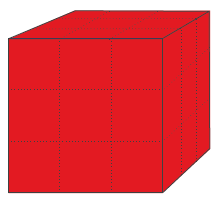This problem solving activity has a geometry focus.

She paints the large cube red.
How many of the original small cubes have:
- three faces painted red
- two faces painted red
- one face painted red
- no faces painted red
- Apply the properties of 3-D shapes to solve a problem.
- Visualise 3-D objects.
- Devise and use problem solving strategies to explore situations mathematically (be systematic).
This problem encourages students to visualise 3-dimensional objects. It is a useful task to get them to think about the problem with their eyes closed. This way they can improve their ability to image 3-dimensional objects. It is also useful to get them to hold cubes in their hands and get a physical feeling for them. Geometrical ability is enhanced by combining the information sent to the brain by all the senses.
Students will also need to know, or quickly be able to find, simple facts about cubes such as the number of faces, corners and edges that they have.
This problem provides the opportunity to introduce a teaching point on Euler’s Polyhedral Formula. For solid figures, such as cubes, which are made up of plane faces without ‘holes', Euler’s formula links the number of vertices (v), edges (e) and faces (f) by the equation:
v – e + f = 2.
The cube provides a simpler illustration of this. Euler's formula can also be applied to other Platonic solids, such as the dodecahedron, the icosahedron, the octahedron and the tetrahedron.
The Problem
Carrie has glued some cubes together to make a large solid cube with nine small cubes showing on a face. She paints the large cube red.
How many of the original small cubes have:
- three faces painted red
- two faces painted red
- one face painted red
- no faces painted red
Teaching Sequence
- Introduce the problem by playing "guess my object". Place a cube into a bag and ask for a volunteer. The students should use their experience of touching the object, but not looking at it, to answer Yes or No to questions asked by the rest of the class. This game helps focus on the attributes of a cube: faces, edges, corners.
- Pose the problem to the class.
- Ask the students for ideas about how they might solve the problem.
- Discuss the resources needed for the ideas offered. For example, isometric paper for drawings or cubes for those who want to make a model.
- Let the students work on the problem in pairs.
- As they work, ask questions that encourage them to explain their understanding of 3-D objects. Look for them to identify the vertices, edges, and faces of the shape, and use the language associated with these features.
- Ask the students to write their solutions in the form of a report that others could follow.
- Share reports.
- Encourage the students to reflect on the solutions of others.
Extension
What percentage of the surface of all of the original cubes is painted?
Solution
- To get three of its faces coloured, the small cubes have to be on the corners of the large cube. There are 8 corners to a cube, so 8 of the smaller cubes have three faces painted red.
- To get two of its faces coloured, a small cube will have to be on the middle of an edge. In fact there is one per edge. As there are 12 edges of the large cube, there are 12 small cubes that have two faces coloured.
- The cubes with one coloured face are in the middle of a face. There are 6 of these.
- Those cubes that haven’t seen any paint must be in the centre of the large cube. There is only one such cube. This can be seen by first noting that there are 9 small cubes to a face. So there are 9 cubes on each of the three levels of the big cube to give a total of 27. Two opposite and parallel faces use up 18 different small cubes. The remaining faces on the outside of the cube are 3 + 1 + 3 + 1 around the ‘middle’ between the two opposite faces. Hence there are 18 + 8 = 26 small cubes on the outside of the large cube. Then there are 27 – 26 = 1 on the inside.
Another approach is that these cubes are equal to (all cubes) minus (the cubes in (i), (ii), (iii) above) = 27 – (8 – 12 – 6) = 1.
Solution to the Extension
To find the required percentage we first work out the number of faces altogether and then the total number of faces painted. Originally we had 27 faces, so there were 27 x 6 = 162 faces.
As far as coloured faces go we have 3 faces for each of 8 cubes, 2 faces for each of 12 cubes and 1 face for each of 6 cubes. This gives a total of 3 x 8 + 2 x 12 + 1 x 6 = 24 + 24 + 6 = 54.
So the percentage of the surface covered is 54/162 x 100 = 33 1/3 %.
Do you find that surprising? Should it have been obvious that only a third of the original faces were coloured?